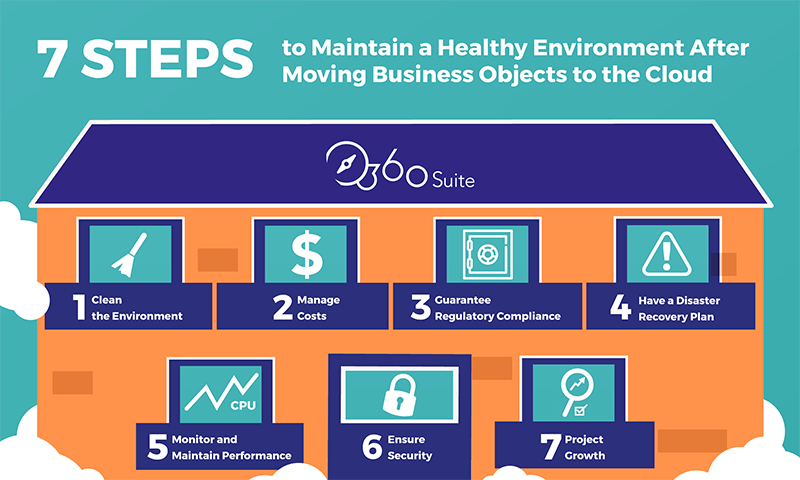Lire cet ebook en Français ![]()
7 Steps to Maintain a Healthy Environment After Moving Business Objects to the Cloud
Moving Business Objects to the cloud is like building a house. Houses require maintenance to remain in pristine condition. Good housekeeping lowers the cost of ownership, ensures optimal performance and enhances security. Previously, 360Suite recommended 10 steps to a successful Business Objects cloud migration. In the next phase, 360Suite recommends 7 steps to maintain a healthy environment after moving Business Objects to the cloud and offers a set of solutions that are equally useful before, during and after a migration. The cloud is no longer a small phenomenon for small and medium-sized agile businesses. Major investments are being triggered by larger companies, and the cloud has become a major BI trend, as seen in our study published at the end of 2019.



Step 1: Clean the Environment
Just as houses fill with clutter, Business Objects environments grow over time and become harder to manage. The larger the Business Objects environment, the more expensive it is to store in the cloud.
360Suite auto cleans by locating, isolating, promoting, archiving and/or deleting content in accordance with pre-established rules (e.g., content that has not been used for at least 13 months). It also eliminates the need to make difficult trade-offs between information and space. For example, deleting bulky data from Business Objects Auditor and storing it in a separate, lightweight 360Suite database both preserves information and saves space.
Step 2: Manage Costs
Just as houses consume energy, Business Objects in the cloud consumes bandwidth. Large, complex reports can even make services unresponsive or unstable.
360Suite provides valuable information about server use over time. Prebuilt Webi reports highlight peaks for the purpose of optimizing server utilization—switching servers off or reducing capacity when not needed. 360Suite can schedule report bursting in off-peak hours to control costs.
Step 3: Guarantee Regulatory Compliance
Just as homeowners must abide by the rules of homeowners associations, organizations must comply with regulatory requirements.
Account Recertification
360Suite answers questions essential for account recertification (Who has access to what? When, where and why?) and launches automated jobs to validate user status.
Documentation
360Suite automates reporting required by SOX, FISMA, HIPAA, GDPR and other regulations.
360Suite allows you to build reports so that you conform to regulatory requirements such as GDPR, SOX, or Solvency. Learn more about the key reports 360Suite can provide you in this ebook.
Archives
360Suite automatically flags and archives content in accordance with regulatory requirements. (For example, SOX requires instances to be maintained for seven years.) 360Suite can archive content to a location in Business Objects on the cloud or to a location off the platform, which saves space on the cloud server.
Suspicious Activity Alerts
360Suite tracks suspicious Business Objects activity such as access/activity outside working hours and exporting data/reports when not required by a user’s job function. 360Suite reports contain information, including the IP address of the machine that logged the suspicious activity, that allows system administrators to act quickly.
Step 4: Have a Disaster Recovery Plan
Just as homeowners need insurance to cover losses, system administrators need disaster recovery plans to handle emergencies. A typical Business Objects recovery strategy includes backing up the entire Business Objects server and CMS database. This allows the full system to be restored in the event of a server crash, but it is not suitable for selective rollbacks or for restoring individual deleted objects. It also fails to address corrupted environments; if an environment is corrupted, so too is the mirrored backup! Finally, full backups may impact platform availability and take down environments for several hours.
360Suite runs delta and dynamic backups, which have no impact on the platform. This enables the selective rollback to previous versions of corrupted objects (personal documents, security settings, user, universe connections, etc.) and the recovery of deleted objects from the 360Suite recycle bin. 360Suite can also sync to organizations’ disaster recovery sites.
Step 5: Monitor and Maintain Performance
Home repairs sometimes have unintended consequences. So do service packs to Business Objects.
360Suite automates Business Objects performance testing to compare report execution times before and after changes to calculation engines, universes, data tables, etc. This information empowers testing teams to identify problems before rolling out new content, and to maintain high quality standards.
360Suite HTML 5 monitoring provides an in-depth look at any process, including CPU and memory usage. It allows system administrators to set alerts and receive notifications when defined thresholds are met.
Step 6: Ensure Security
Just as homeowners locks doors to safeguard property, system administrators must take steps to ensure the security of Business Objects in the cloud.
360Suite details permission assignments and inheritances attached to individual users, groups and Business Objects resources, from applications to individual reports. This information allows system administrators to monitor security and proactively prevent breaches.
Step 7: Project Growth
Wise homeowners plan for the future, when family size or budget may impact housing considerations. Wise Business Objects administrators plan for the future by projecting growth and considering its impact on Business Objects in the cloud.
360Suite collects information on usage, memory needs, and licensing. It generates reports that allow decision-makers to plan for the future and adjust Business Objects content and cloud capacity accordingly.
Conclusion
360Suite is a suite of agile governance solutions for SAP BusinessObjects developed by Wiiisdom.
At Wiiisdom, we transform your Analytics landscape into a reliable place to make better, trusted decisions every day and maximize your data assets.
360Suite is a set of solutions to ensure quality, reliability, performance, and efficiency of SAP BusinessObjects through testing, auditing, monitoring, cataloging, and scheduling methodologies. 360Suite is designed for large organizations looking to mitigate data risks, automate operations, and is the solution of choice for any migration project.


